Abstract
High-energy neutrino astronomy is a fascinating new field of research, rapidly developing over recent years. It opens a new observation window on the most violent processes in the universe, fitting very well to the concept of multi-messenger astronomy. This may be exemplified by the recent discovery of the high-energy neutrino emissions from the -ray loud blazar TXS 0506+056. Constraining astrophysical neutrino fluxes can also help to understand the long-standing mystery of the origin of the ultra-high energy cosmic rays. Astronomical studies of high-energy neutrinos are carried out by large-scale next-generation neutrino telescopes located in different regions of the world, forming a global network of complementary detectors. The Baikal-GVD, being currently the largest neutrino telescope in the Northern Hemisphere and still growing up, is an important constituent of this network. This paper briefly reviews working principles, analysis methods, and some selected results of the Baikal-GVD neutrino telescope.
1. Introduction
1.1. Multi-Messenger Astronomy
Detection of hundreds TeV and PeV neutrinos, a remarkable achievement of the last decade [1,2], gave rise to a new rapidly developing field of astrophysics—high-energy neutrino astronomy—a novel instrument to observe catastrophic processes occurred to the earlier Universe.
Such processes (emissions from blazars as an example) send outwards lots of messengers—photons, hadrons, charged, and neutral leptons. When possible, their detection, the subject of multi-messenger astronomy, helps to reconstruct stories of the corresponding dramatic events. Neutrinos, due to their weak interaction, escape the dense regions being almost unaffected in contrast to other particles loosing their energies and, if electrically charged, deflected by magnetic fields.
An identification of the flaring -ray blazar TXS 0506+056 as a source of both a 290 TeV IceCube-170922A event [3] and a neutrino flux at lower energies [4] along with the first observation of the electromagnetic counterpart of gravitational wave event [5,6] (originated from the merger of two neutron stars, event GW170817) were the milestones leading to the beginning of the multi-messenger astronomy era. Recently, evidence was found to show that active galactic nuclei (AGN), associated with astrophysical neutrinos detected by the IceCube observatory are also more active in radio range [7,8], which could provide a further insight about the physics processes in AGN.
Joint observations of astrophysical objects with neutrinos, electromagnetic and gravitational waves provide further insights on the extreme phenomena occurred in the Universe.
1.2. Short Story of Neutrino Telescopes
The story of neutrino telescopes dates back to the proposals published in 1960 by Greisen [9], Reines [10] and Markov [11], where natural reservoirs of water or clear ice were suggested as both a target volume for neutrino interaction and a Cherenkov radiator for detection of charged particles. These volumes, instrumented with three-dimensional arrays of photo-detectors, allow reconstructing the direction, energy and type of the primary particle.
The construction of the first underwater telescope began as the DUMAND ( Deep Underwater Muon And Neutrino Detector) project [12,13] in 1976 near the Hawaii island. Although in 1995 the project was canceled, it uncovered many deployment issues which had to be addressed by following telescopes in the next decades.
Since then the effort to begin high-energy neutrino astronomy has moved towards projects conducted at Lake Baikal (Baikal-NT, Baikal Neutrino Telescope [14,15]), at the South Pole (AMANDA, Antarctic Muon And Neutrino Detector Array [16,17]), and in the Mediterranean sea (NESTOR (Neutrino Extended Submarine Telescope with Oceanographic Research Project) [18] and ANTARES (Astronomy with a Neutrino Telescope and Abyss Environmental Research) [19,20]). These projects pioneered the field proving the neutrino telescopes concepts and providing the flux measurements of atmospheric muons and the first upper limits on the diffuse fluxes of high-energy extraterrestrial neutrinos [21,22,23,24,25,26].
In the end of the twentieth century AMANDA-II [27], the largest telescope at that time, increased its total instrumented volume to about 0.03 km3.
1.3. Global Neutrino Network
The next generation of neutrino telescopes aimed to increase their volumes to about one cubic kilometer (and the IceCube reached this goal) in order to probe astrophysical high-energy neutrino. Their sensitivity and sky coverage are expected to enhance further by their combination into the so-called Global Neutrino Network (GNN). It aims for a closer collaboration and a coherent strategy among the high-energy neutrino telescope projects worldwide, exploiting the synergistic effects of cooperation (exchange and mutual check of software, creation of a common software pool, cross-check of the results, management of the multi-messenger alerts, etc.).
At present four collaborations form the GNN: (i) ANTARES [19], (ii) Baikal-GVD [28], (iii) IceCube [29] and (iv) KM3NeT (Cubic Kilometre Neutrino Telescope) [30]. The Baikal-GVD is currently the largest deep underwater neutrino detector with total sensitive volume for cascade shower events of about 0.35 km3. In addition to the expected increase in the common instrumented volume of the GNN due to the ongoing construction of KM3NeT and Baikal-GVD. A major improvement is expected by the so-called IceCube Upgrade [31], being the first stage of the IceCube-Gen2 telescope, second generation of IceCube detector [32]. Its projected volume of 8 km3 is foreseen as a successor of the IceCube observatory.
1.4. Science Case
The physics program of the high-energy neutrino telescopes is manifold. The primary mission of these facilities is a search for the sources of the highest energy phenomena occurred to the Universe. Among possible candidates, AGN, -ray bursts (GRBs), starburst galaxies and galaxy clusters are expected to generate neutrinos in the energy range of 10 TeV to 100 PeV or even higher. Our galaxy is expected to produce neutrinos with energies below ∼1 PeV by supernovae (SNe) and their remnants, pulsars, the black hole Sgr A* located at its center, binary systems containing a black hole or a neutron star, and clusters of molecular clouds that are targets for cosmic-rays.
Another direction of research of the astrophysical neutrinos is the detection of the diffuse neutrino flux from unidentified sources (based on the signal excess over the background of atmospheric neutrinos) and investigation of its energy spectrum, global anisotropies, and neutrino flavor composition. The diffuse neutrino flux results from the neutrino emission by various sources at different times, starting from the remote cosmological epochs up to the present day. Part of this flux is produced during interactions of cosmic rays with matter and in the case of the ultra-high energy cosmic rays also with the cosmic microwave background.
Neutrino telescopes will substantially contribute to multi-messenger astronomy by providing information complementary to that obtained by other astronomical instruments. This new field of astronomy aims at simultaneous observation of astrophysical sources with cosmic rays, neutrinos, photons across a broad range of wavelengths and gravitational waves, and is based on searching for their temporal and spatial coincidences. It represents a powerful tool to provide a multi-faceted picture of the high-energy non-thermal processes in the universe. Combined study of the chosen events with different detectors may lead to a higher significance of the final results.
The alert system of the Global Neutrino Network provides real-time, on-line communications not only between neutrino telescopes but also with other types of observatories. It enables simultaneous observations of the same part of the sky by multiple detectors and retrospective search of already recorded data for events that came from the region of interest. In coincidence with other multi-messenger facilities, neutrino telescopes can be used to investigate the origin (and thus also the composition [33]) of the ultra-high energy cosmic rays. If the same acceleration mechanisms are responsible for the observed spectrum of cosmic rays, -rays, and high-energy neutrinos, the expected connection between luminosities in these three channels of emission can be used to predict the neutrino flux. It would enable us to put some constraints on the proposed models of cosmic rays acceleration [34,35,36,37,38].
This article briefly reviews the Baikal-GVD deep underwater neutrino telescope, its current status and future perspective. The outline of the paper is as follows. In Section 2 we give the general description of the Baikal-GVD detector and its working principles. In Section 3 we summarise the simulations performed by the Baikal Collaboration, which are essential for the data analysis. Section 4 and Section 5 briefly introduce methodology of the events reconstruction and the most important results obtained so far. Finally, the paper ends with a short discussion given in Section 6.
2. Description of the Baikal-GVD Telescope
2.1. General Description
The Baikal-GVD (Baikal Gigaton Volume Detector) experiment uses the deep underwater detection technique, which is based on recording Cherenkov radiation from secondary muons or high-energy showers emerging from the neutral and charged-current interactions of high-energy neutrinos with the bedrock or the water of Lake Baikal.
The Baikal-GVD telescope has a modular structure—it consists of several sub-arrays (clusters). They are located deep (∼1 km) in the water of Lake Baikal at a distance of about 4 km from the shore. Placing them several hundred meters underwater makes the atmospheric muons background produced by cosmic rays less severe. Each cluster is functionally independent and contains 8 vertical load-bearing cables (strings), one in the center and seven peripheral ones as can be seen in the left panel of Figure 1. In the years 2015–2020, seven clusters in total were installed as illustrated in the right panel of Figure 1. Strings within each cluster are separated by ∼60 m, distance between central strings of neighbouring clusters is ∼300 m. At depths of 750 to 1275 m, strings are instrumented with the basic detection units — optical modules (OMs, photomultiplier tubes (PMTs) enclosed in the pressure-resistant glass spheres) spaced by 15 m.
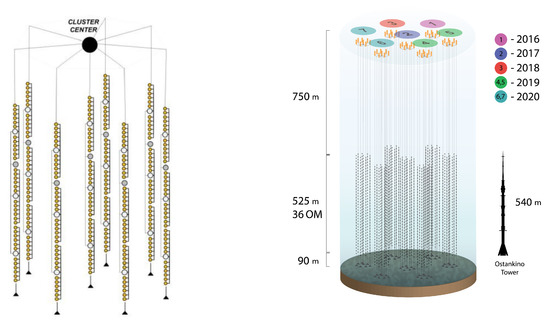
Figure 1.
Left panel. A schematic view of single Baikal-GVD cluster with seven strings along a circle and one central string. Solid circles correspond to optical modules (OMs). Open circles illustrate electronics modules of a section (CMs). Right panel. A schematic view of seven Baikal-GVD clusters installed in the period 2015–2020.
Each OM is equipped with a photomultiplier tube Hamamatsu R7081-100 with a 10-inch hemispherical photocathode and quantum efficiency up to 35% for Cherenkov light detection. The optical contact between the photocathode region of the tube and the pressure sphere is provided by optically transparent silicone gel. A high permittivity alloy cage surrounds the PMT, shielding it against the Earth’s magnetic field. A vacuum valve allows evacuating the sphere down to 0.7 atm. The OM is equipped with one deep-underwater connector (SubConn Low Profile 5-contacts). It is used for analog pulse transmission, slow control (2-wire RS-485) and OM power supply (12 VDC). The OM electronics includes a controller, a high voltage power supply unit, a fast two-channel amplifier, and a LED flasher. All the equipment is enclosed in a 17-inch transparent pressure-resistant VITROVEX glass sphere [39].
The optical modules at each string are organised in three sections, each containing 12 OMs oriented towards the lake floor with dedicated electronics and a central electronics module (CM). The PMT signals of OMs are amplified and transmitted to the ADC units to measure the pulse shape with a sampling rate 200 MHz [40]. The ADC units are located in the central modules of each section. The digitized signals are then transferred to a memory buffer to form a trigger request signal, which is subsequently transferred to the central module of the cluster (CCM). The distances between the central strings of neighboring clusters are 300 m. Clusters are connected to the shore via individual electro-optical cables used for transmitting electrical power and data. By design, the Baikal-GVD telescope is the most sensitive to the upward or nearly horizontal neutrinos and neutrino energies between about 0.1 TeV and 100 PeV.
2.2. Deployment and Maintenance
Lake Baikal, in addition to the very favorable properties of water, has unique hydrological and geophysical properties, which makes it an excellent place for the installation of a neutrino telescope. In an especially selected location for the Baikal-GVD telescope, the bottom of the lake is very smooth and relatively flat, thanks to which it is much easier to anchor strings to the lake floor. Moreover, this area is so large that it is possible to extend the modular structure of the telescope to the very large active volumes.
The Baikal Lake, thanks to its location, has one more feature—the periodic ice cover allows easy and cheap installation of new clusters and maintenance of the existing infrastructure. The Lake usually starts to freeze at the end of January. In mid-February, the ice cover reaches a thickness of about 40–50 cm, and its strength is sufficient to enable safe transportation and deployment of heavy equipment and vehicles. At that time the Baikal-GVD Winter Expedition typically begins. The duration of the expedition is usually 6–8 weeks depending on the thickness of the ice cover. The evacuation of the Ice Camp usually begins in the last days of March or the first days of April. The withdrawal of equipment from the lake marks the official end of the Winter Expedition.
During the Winter Expedition, in addition to providing a platform for equipment above the telescope structures, nature comes to our aid again. The average daily temperature during the expedition varies in the range from –3 to +10 Celsius degrees (during sunny days even more). The temperature above 0 is a great backup when it comes to pulling out steel elements, ropes and optical modules from the water to the ice surface. Another feature of the lake is that the ice layer is very stable and it only slightly moves during the expedition time, thanks to that it is possible to precisely locate the strings placed on the bottom of the lake.
The procedure of dismounting and mounting the optical modules on deployed strings being repaired does not differ significantly from the procedure of mounting OM’s on new strings. The string (actually a steel rope) on the winch drum is equipped with an appropriately selected anchor, and after unrolling it to relax and avoid excessive twist (until the anchor touches the bottom), it is pulled out to the surface again. Markers are placed under the clamp of each component, making it easier to reinstall the element in exactly the same position in the event of a string service in the following year.
After installation, the optical module is tested under water to avoid having to disassemble the modules in the event of failure of one of them later in the assembly phase. The assembly procedure is much faster than disassembly. The crew of the winch usually consists of three people - the winch operator and two string operators. If the weather and technical conditions are good, the team is able to deploy a new string within two days. Of course not the whole Baikal expedition crew work on ice. Part of the team work in laboratories on the Lake shore where OM’s and components of the calibration systems (acoustic system, lasers etc.) are being tested and repaired.
2.3. Trigger System
The signal produced by PMT of optical module is transmitted to the ADC unit in the section central module (CM). Each ADC unit is equipped with quartz oscillators allowing for measurement of the arrival time of photons. Event times measured by different ADC units within the same cluster are unified to a single time scale with an accuracy of about 2 ns by a global trigger signal. The local trigger signal is generated by CM if two pulses at adjacent modules with charge above and coincident within 100 ns window are found. Typical values for and are 3–5 and 1–2 photoelectrons, respectively. The trigger signal is sent to the cluster center module (CCM) through 1 km-long line. CCM generates an acknowledgement signal to all central modules (CM) in a cluster, when the request signal is received. When CM receives the signal, a timestamp is defined and the CM starts to form the data. The existing memory buffer allows for acquiring the OM signal waveform in a time window of 5 s. The information is then transferred to the shore station and stored as raw data. Such a trigger system approach allows having all signal waveforms on each channel in an event from only one triggered pair of neighbouring channels, while the data arriving from sections can be processed in real time mode [40].
2.4. Detector Calibration
The signal of a muon neutrino in the detector is usually a muon track emerging from charged-current interaction of with a nucleus. This channel of search for astrophysical neutrinos provides the best angular precision () and allows for examining the point sources of emission. High precision of time measurement and OM position calibration are crucial to attain the best angular precision. It is worth mentioning that in order to correctly reconstruct a signal, it is also important to distinguish whether the detected particle is up- or down-going. Down-going muons registered by the Baikal-GVD telescope are hardly ever results of neutrino interaction but arise from background processes, yet their rate is many orders of magnitude larger than that of expected signal.
2.4.1. Time Calibration
Each measurement channel (corresponding to one OM) has its own time delays due to several factors, such as internal transit time of each OM photomultiplier, different lengths of connecting cables and processing times of the electronics. The procedures for hardware-based time calibration exist in the Baikal-GVD experiment [41,42] and consist of three subsequent steps—the intra-section, inter-section and inter-cluster calibration. In the first step, the relative time-delays between the 12 OMs in each section are derived. The second step provides relative time-offsets between the 24 sections in each cluster whereas the third step provides the relative time differences between all installed Baikal-GVD clusters. Multiple time-calibration systems were installed in the Baikal-GVD telescope. In every OM, the so-called test pulse can be created via the electronics controller and sent directly to the amplifier and its production time can be compared with the time of LED light production. This allows for measuring the delay time in the photomultiplier itself. The two built-in LEDs (Kingbright L-7113PBC-A) of each OM can be used for the basic intra- and inter-section calibration. The time offsets between the generation of LED pulse (accompanied by test pulse in the electronics) and its arrival in the same OM can be measured as well as the differences between the expected and measured arrival times of signals induced by LED flashes in the neighbouring OMs. In addition, each cluster contains 4–5 LED matrices that can be used for inter-section calibration in a similar way. An LED matrix contains 12 LEDs enclosed in a separate 17-inch glass sphere (see Figure 2) and is able to illuminate OMs up to 100 m distance.
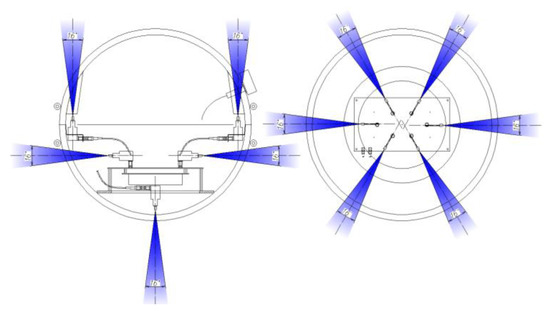
Figure 2.
LED matrix with beam directions [43]. Shown are the vertical (left) and horizontal (right) intersections of the LED matrix module. There are 6 LEDs directed horizontally (right) with the 60 distribution across the entire plane and 6 LEDs directed vertically (left). Please note that due to the symmetry of the module, only 1 out of 2 LEDs looking downwards and 2 out of 4 looking upwards are visible in the figure.
The time calibration of the Baikal-GVD optical modules has been performed and the resulting precision (cross-checked by two independent methods) is approximately 2.5 ns for both the intra- and inter-section calibrations, which is close to the designed precision and can be improved further. Moreover, a common synchronisation clock together with an especially designed system of high-power pulsed lasers installed in-between the Baikal-GVD clusters should allow for the subsequent merging of the physics event data collected from the different clusters. These devices can also be used for light propagation studies.
2.4.2. Charge Calibration
The signal in the optical modules, caused by Cherenkov photons, is recorded as electric impulses. The presence of the pulse is detected if the recorded voltage exceeds the threshold of variation of the pedestal voltage, calculated from the first few samples of the recorded waveform, preceding the pulse itself. The charge integration is extended over samples below the threshold at the beginning and at the end of the pulse to better account for the charge in small pulses [42]. The small pulses (1–2 photoelectrons) are used for charge calibration of the individual OMs. The mean value of the charge (in FADC channels) of the single photoelectron peak is assigned 1 photoelectron. The positions of single-photoelectron peaks are stored in the experiment’s database for every OM and for every run and are used to transform the values of impulse charges from the units of FADC channels to photoelectrons.
2.4.3. Water Properties
The Baikal Lake forms a very good environment for the installation of a neutrino telescope, most of which have been already mentioned. The knowledge of the properties of its waters is crucial for good understanding of the measurements performed with the Baikal-GVD detector. The luminescence of water in the Lake was measured in the 1980’s [44]. It is primarily related to oxidation processes of active organic radicals. The substances that can emit light are produced near the surface of the lake. The light field at large depth is formed by the transport of luminescent matter to the deep layers. The luminescence intensity of an isolated water volume decreases exponentially over time.
The luminescence decreases with depth and at 1000 m below surface its photon flux density amounts to a few hundred photons/(cm2s). The influence of sunlight at the depth of 700 m is negligible. The PMT discharge rate due to chemiluminiscense is monitored by means of offline data analysis and also dedicated online monitoring system, both methods demonstrate similar results. The noise rate depends on the season and depth, and typically constitutes about 20–50 kHz in April - June and can go beyond 100 kHz on topmost OMs in the rest of the year [45]. The ambient background light is registered in addition to the Cherenkov light.
The measurements were performed using data collected between 2016 and 2018 and using two independent systems—telescope trigger and an online monitoring system. Both show similar features, with periods of increased luminescent activity (in 2016 and 2018) and a period of stable optical noise in 2017. In the periods of increased activity we observe upward flows of luminescent water with a velocity of 45 m/day. In all these periods the distribution of charge is unchanged. The online noise monitoring system is operating during the data-collection periods and is completely independent from the detector trigger system.
In Figure 3 we display an example of the background count rate measured at several depths in the lake Baikal during several months in 2016–2017. The background rate decreases with depth to some 20 kHz at depth 1.2 km and increases up to some 180 kHz at depth 750 m during active periods. This is a unique data for limnology and environmental studies.
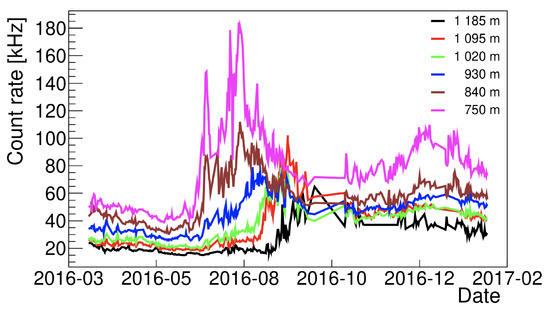
Figure 3.
The background count rate (in kHz) as measured at several depths in the Lake Baikal during several months in 2016–2017.
The in situ measurements of the inherent optical properties of the Baikal water had been also performed [44]. For a reference the following values could be indicated to illustrate the optical properties of the Baikal water. The absorption length m, the scattering length –70 m and the average cosine of scattering angle, . Figure 4 illustrates the quantities in more details, including also the probability density function of light scattering. As we can see the scattering is strongly forward beamed. There is only negligible dependence of the discussed water properties on the depth and temperature in contrast to their seasonal variation.

Figure 4.
Left panel. Probability density function of light scattering as function of , where is the scattering angle. Right panel. Absorption and scattering lengths vs. photon’s wavelength.
2.5. Acoustic Positioning System
The OMs of the Baikal-GVD telescope can drift even beyond 50 m from their median position because of string flexibility and water currents in the Lake. Monitoring of individual OM positions is crucial to minimise measurement errors in the reconstruction procedures. This is achieved with the help of the Acoustic Positioning System (APS) [46].
The APS is built of EvoLogics S2C R42/65 acoustic modems (AM), which are mounted on the detector strings. Three downward-oriented AM beacons are installed on each string, with a bottom beacon or an upward-oriented AM node. The position of each node is assumed to be constant as it is attached to the base of the string, next to its anchor. The coordinates of the beacons are acquired by measuring the acoustic distances to the antenna formed by the nodes at the bottom of the Lake. The coordinates of the beacons are reconstructed online. The beacons are polled for acoustic distances in few minutes intervals, the reconstruction is performed afterwards and the positions are stored in the data storage. The coordinates of OMs are obtained from interpolation based on piecewise-linear model of the string. The basic layout of the AM modules as of 2019 is presented in Figure 5. The spatial orientation of OMs is determined from the accelerometer and compass magnetic sensors installed in the OMs independently from APS.
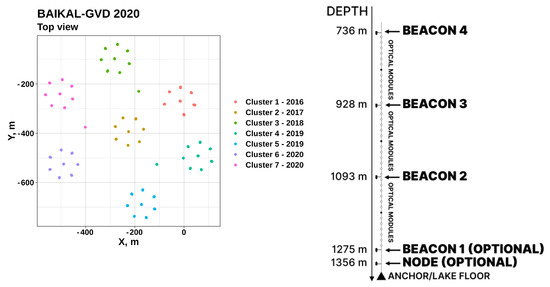
Figure 5.
The horizontal and vertical layout of the Acoustic Positioning System beacons [46].
The measurements performed with the APS show that the beacon drift is mainly lateral. The variation of their vertical position does not exceed 0.5 m and occurs only during short periods of active drifts in autumn. The lateral (horizontal) changes of beacon positions vary from 50 m of the top beacons (at 736 m depth) to 5 m at the depth of 1274 m. The top beacons drift with an average (all-time) speed of 0.5 cm/s with maximum speed not exceeding 3 cm/s (during turbulent period caused by strong currents). The precision of the acoustic positioning is related to the intrinsic AM precision (few centimeters), precision of OM position interpolation (increasing with OM distance to the beacon) and to the beacon mobility. The mean position error, obtained for additional test beacons, was estimated to be below 20 cm (less than the photocathode diameter), similarly to that of other large-scale neutrino telescopes [47,48]. This precision was expected at detector design stage and is similar in other large scale neutrino telescopes.
3. Simulation
The simulation of events recorded by the detector is essential for understanding both the detector response and the physics of the studied processes. It is a complex task, which consists of several separate steps, all requiring dedicated approaches. These include the generation of incoming particles of interest (neutrinos and muons), propagating them through the material before reaching the active volume of the detector (Earth, lake water, bedrock, etc.) and, last but not least, the simulation of the detector response to the incoming particles.
The fluxes of atmospheric neutrinos and muons had already been calculated in Refs. [49,50] and the results of those calculations were implemented in the simulation framework. The propagation of muons through the matter is performed by a MUM (MUons+Medium) software package [51] that has also been integrated into the simulation framework.
The neutrino-nucleon charged current (CC) and neutral current (NC) deep inelastic cross-sections had been obtained in Ref. [52]. Figure 6 displays the corresponding neutrino-nucleon cross-sections. Neutrino propagation through the Earth accounts for neutrino absorption and energy losses in NC interactions by Z-factor method used for a solution of the transport equation developed in Ref. [53]. As an illustration, the probability of no-absorption of muon neutrino, propagating through the Earth to a detector at 1 km depth, as a function of neutrino energy and zenith angle, is shown in Figure 7.
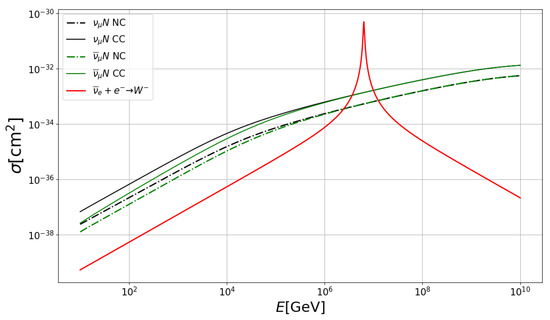
Figure 6.
Neutrino-nucleon charged current (CC) and neutral current (NC) deep inelastic cross-sections as a function of neutrino energy. The target nucleon was assumed to be isoscalar. MRST04 [54] (next-leading-order in pQCD) parton distribution functions, including next-leading-order QED corrections to the parton evolution, were used in calculation of the cross-sections [52]. Note the log scales for both horizontal and vertical axes. Also shown the cross-section for process which has resonant behaviour around PeV (the Glashow resonance).
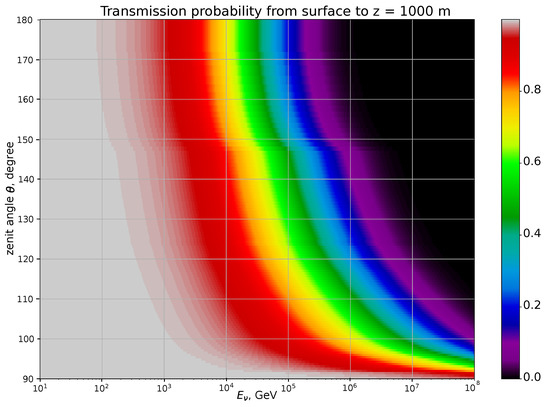
Figure 7.
The probability of no-absorption of muon neutrino, propagating through the Earth to a detector at 1 km depth, as a function of neutrino energy and zenith angle. Note the log scale for horizontal axis.
The propagation of secondary particles, the production and propagation of Cherenkov light and the simulation of the detector response is then computed using a dedicated proprietary software that is based on the GEANT4 [55] package and implements additional features to account for the sparse structure of the Baikal-GVD detector (such as the use of pre-generated light fields instead of CPU-consuming full GEANT4 simulations).
4. Reconstruction
Detection of neutrinos is only possible by detecting secondary particles produced in their interaction with matter – in the case of Baikal-GVD – with the bedrock or lake water. The secondary charged particles traversing the lake produce Cherenkov radiation, which can be recorded by the telescope’s optical modules. The type of charged particles produced in neutrino-matter interactions, and, consequently, the pattern of Cherenkov light produced both depend on neutrino flavour and type of the interaction. Interactions mediated by (CC interactions) are accompanied by the hadronic shower at the interaction vertex and depending on the neutrino flavor either an electromagnetic cascade from e for or a muon track for and electromagnetic or hadronic cascade or muon track for according to branching ratios. Interactions mediated by Z-boson are accompanied by hadronic cascade and outgoing neutrino which is not visible. In this section we describe the reconstruction procedures for a single-cluster operation mode.
Muons produced in CC interactions have a large propagation range and loose energy mainly due to ionisation, pair production, bremsstrahlung and photonuclear reactions. Ionisation dominates at energies below ∼1 TeV, when energy loss is equal to 2 MeV/cm. For higher energies energy loss is larger and roughly proportional to the muon energy and manifests itself as electromagnetic or hadronic showers along the muon track.
The reconstruction of muons is performed in two stages. At first stage the background pulses from chemiluminescence are suppressed. Pulses are clustered around seed pulse with high charge deposition using time and distance constraints. At the second stage the muon track parameters are reconstructed by means of minimisation of the quality function , where is the chi-square sum of time residuals with respect to direct Cerenkov light from the muon, is the sum of products of charges deposited in OMs and their distances from the track and w is the relative weight of the second term. Events with at least 6 pulses found at 2 strings are used for the reconstruction. The developed procedure is optimised for low-energy muon reconstruction, while for high energies fit with dedicated likelihood function, which takes into account late hits from showers accompanying the muon track, is required. Such procedure is in development. The muon reconstruction provides the precision of the incident angle estimation of around 1.
Length of cascades is of the order of PMT spacing while angular distribution of charged particles inside the cascade is wide, which makes it a quasi-point-like source of Cherenkov light. The reconstruction of cascades [56] is performed in two steps. First, the vertex coordinates are reconstructed using timing information from optical modules assuming the source is point-like. A maximum-likelihood method is employed in the second step to estimate the energy and direction of the considered cascade using the information on the vertex from the first step and the amplitude data from OMs. The angular precision of cascade-reconstruction channel is around 4 whereas the uncertainty of its energy measurement—for 100 TeV cascades – is [57].
5. Selected Results
The Baikal-GVD experiment has been collecting data since 2015, when the first cluster was installed and the first neutrino-candidate event with energy of about 100 TeV was recorded [58]. Up to now data from each Baikal-GVD cluster is being analysed independently what is referred to as single cluster analysis while the multi-cluster analysis is in preparation. In the data collected in 2016 and 2017, several cascade-like candidate events were recorded. After causality and OM-multiplicity criteria were applied, 57 events with TeV were selected. The distribution of their OM-hit multiplicity is shown in Figure 8 (left panel). Most of the events follow the distribution expected for atmospheric muons except for one with the multiplicity of 38 OMs. This event was further re-analysed and the parameters of the cascade were the following: energy TeV, zenith angle and azimuthal angle [58] with energy uncertainty of 30% and angular precision of .
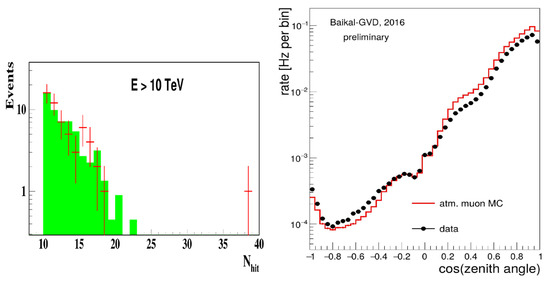
Figure 8.
Left panel. Measured distribution of hit OMs multiplicity in cascade-like events with energies above 10 TeV and distribution expected for atmospheric muons (green histogram) [58]. Right panel. Reconstructed muon zenith angle distribution in cluster 1 of 2016 season. Data are compared to MC simulation based on CORSIKA event generator [59]. Decent agreement of data and MC simulation is demonstrated.
Distribution of zenith angle for tracks reconstructed in the low-noise period of 2016 with minimal quality requirements is shown in Figure 8 (right panel). A small percentage of events are reconstructed as up-going muons forming a background to up-going neutrino events exceeding the atmospheric neutrino flux by a factor . To suppress the background from mis-reconstructed tracks a set of cuts on 13 reconstructed track parameters is used. For the single cluster analysis, the zenith angle is constrained to to ensure sufficient length of the track for high quality reconstruction. Median angular resolution for events passing the analysis cuts is ∼1.0. The developed cuts were applied to a collection of runs from 1 April to 30 June 2016 (low-noise period). The total live time of selected sample is 323 days of single cluster data-taking. A total of 57 neutrino candidate events were selected while the expectation from atmospheric neutrino MC simulation is 54.3 events [57,60]. An example of the neutrino candidate event is demonstrated in Figure 9.
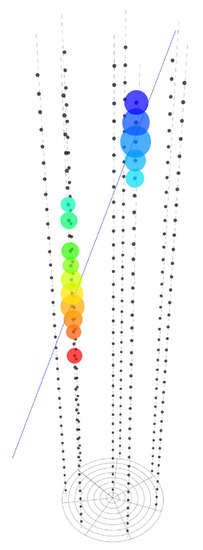
Figure 9.
An example event. Neutrino candidate detected on June 11th in cluster 1 with reconstructed zenith angle . Early hits are shown as red and late hits as blue circles.
In addition to the analyses based solely on the information from the Baikal-GVD telescope alone, an important tool to study astrophysical events is the multi-messenger astronomy which combines the observations of cosmic rays, neutrinos, gravitational waves and photons. A search for neutrinos accompanying the gravitational-wave event registered by the LIGO (Laser Interferometer Gravitational Wave Observatory) and Virgo [6] experiments, GW170817, was performed in the Baikal-GVD with two operational clusters in 2017. In the search for prompt emission ( s) the source of GW170817 was slightly below the horizon. Nevertheless, no neutrino events associated with these sources were found both in the prompt emission and the delayed emission (up to 14 days after alert times). Assuming an spectral behavior and equal fluence in neutrino flavors, upper limits at 90% c.l. have been derived on the neutrino fluence from GW170817 for each energy decade as shown in Figure 10 [61].
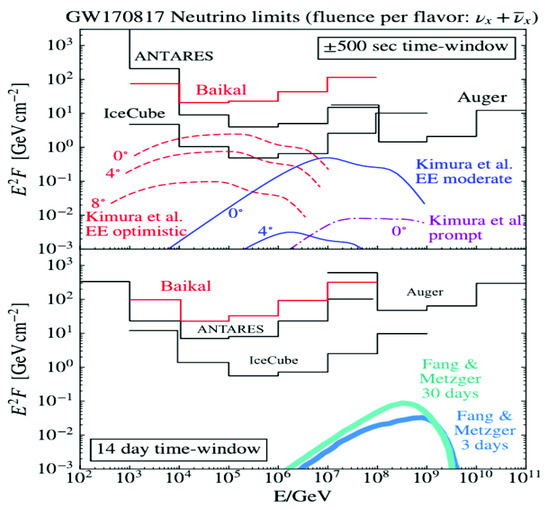
Figure 10.
Upper limits at 90% C.L. on the fluence of neutrinos associated with GW170817 for prompt and delayed emission time [61].
6. Discussion and Future Prospects
The unique possibility of examination of the nature of the ultra-high energy cosmic ray sources or research in neutrino physics is provided by the high-energy neutrinos that can be detected by the dedicated large-scale telescopes. The IceCube neutrino detector located at South pole has opened a new observation window to the Universe. The further development of high-energy neutrino astrophysics requires constructions of gigaton volume neutrino telescopes such as Baikal-GVD and KM3NeT.
The Baikal-GVD, which is currently the largest of the working neutrino telescopes in the Northern hemisphere, is under active construction as well as KM3NeT and the IcuCube Upgrade. Parallel data taking by the neutrino telescopes, situated in different places over the Earth, is beneficial in continuous monitoring of the entire sky for studies of transient high-energy phenomena. Combinations of the GNN will increase a significance of the common analyses, mutual cross checks and alert program.
The Baikal-GVD is expected to be an important pillar, boosting the development of this new field of research further.
The data collected by the Baikal-GVD telescope can be used for searches of the high-energy neutrino signals from various sources. The alert system of the Baikal-GVD will allow for a fast, on-line reconstruction of high-energy neutrino events recorded by the detector and for the formation of an alert message to the other multi-messenger facilities. An example of the corresponding multi-messenger analysis performed by Baikal-GVD Collaboration is the search for coincidences between gravitational wave event GW170817A and detection of the high-energy neutrinos [62].
The first construction phase of the Baikal-GVD is going to be finished by 2024, increasing the cascade sensitive volume of the detector to 0.75 km3 (15 clusters) [57,60]. The further development is foreseen in the following years (expanding the size of the detector up to 1.5 km3). The Baikal-GVD has the potential to record astrophysical neutrinos with flux values measured by the IceCube [2] already at early stages of the array development.
Author Contributions
Conceptualization, D.N., P.M., J.S.; methodology, D.N., V.A., A.K.; software, D.N., V.A., A.K.; validation, D.N., V.A., A.K.; formal analysis, D.N., V.A., A.K.; investigation, D.N., V.A., A.K.; resources, D.N., V.A., A.K.; data curation, D.N., V.A., A.K.; writing—original draft preparation, J.S., P.M., D.N., V.A., A.K., K.K., W.N.; writing—review and editing, J.S., P.M., D.N., V.A., A.K.; visualization, D.N., V.A., A.K.; supervision, D.N., P.M., J.S.; project administration, D.N., P.M., J.S.; funding acquisition, D.N., P.M., K.K., J.S. All authors have read and agreed to the published version of the manuscript.
Funding
This research was funded by the Plenipotentiary Representative of the Government of the Republic of Poland at JINR in Dubna under the Projects No. 75/09/2020 and by the Ministry of science and higher education of the Russian Federation under the contract No. 075-15-2020-778.
Institutional Review Board Statement
Not applicable.
Informed Consent Statement
Not applicable.
Data Availability Statement
Not applicable.
Acknowledgments
This research has been supported in part by PLGrid Infrastructure and we warmly thank the staff at ACC Cyfronet AGH-UST for their always helpful supercomputing support. We acknowledge critical comments and discussions with our colleagues I. Belolaptikov, G. Domogatski, B. Shaibonov, G. Safronov, D. Zaborov—members of the Baikal-GVD Collaboration which helped us to improve the clarity and coherency of this manuscript.
Conflicts of Interest
The authors declare no conflict of interest.
Abbreviations
The following abbreviations are used in this manuscript:
| AM | acoustic modems |
| AMANDA | Antarctic Muon And Neutrino Detector Array |
| ANTARES | Astronomy with a Neutrino Telescope and Abyss Environmental Research |
| APS | Acoustic Positioning System |
| Baikal-GVD | Baikal Gigaton Volume Detector |
| Baikal-NT | Baikal Neutrino Telescope |
| DUMAND | Deep Underwater Muon And Neutrino Detector |
| GNN | Global Neutrino Network |
| IceCube-Gen2 | Second Generation IceCube |
| CC | charged current |
| CCM | central module of the cluster |
| CM | central electronics module |
| KM3NeT | Cubic Kilometre Neutrino Telescope |
| LIGO | Laser Interferometer Gravitational Wave Observatory |
| NC | neutral current |
| NESTOR | Neutrino Extended Submarine Telescope with Oceanographic Research Project |
| OM | optical module |
| PMT | Photomultiplier Tube |
References
- Aartsen, M.G.; Abbasi, R.; Abdou, Y.; Ackermann, M.; Adams, J.; Aguilar, A.; Ahlers, M.; Altmann, D.; Auffenberg, J.; Bai, X.; et al. (The IceCube Collaboration). Evidence for High-Energy Extraterrestrial Neutrinos at the IceCube Detector. Science 2013, 342, 1242856. [Google Scholar] [CrossRef] [PubMed]
- Aartsen, M.G.; Ackermann, M.; Adams, J.; Aguilar, J.A.; Ahlers, M.; Ahrens, M.; Altmann, D.; Anderson, T.; Arguelles, C.; Arlen, T.C.; et al. (The IceCube Collaboration). Observation of High-Energy Astrophysical Neutrinos in Three Years of IceCube Data. Phys. Rev. Lett. 2014, 113, 101101. [Google Scholar] [CrossRef] [PubMed]
- The IceCube; Fermi-LAT; MAGIC; AGILE; ASAS-SN; HAWC, H.E.S.S.; INTEGRAL; Kanata; Kiso; Kapteyn; et al. Multimessenger observations of a flaring blazar coincident with high-energy neutrino IceCube-170922A. Science 2018, 361, eaat1378. [Google Scholar] [CrossRef] [PubMed]
- Aartsen, M.G.; Ackermann, M.; Adams, J.; Aguilar, J.A.; Ahlers, M.; Ahrens, M.; Al Samarai, I.; Altmann, D.; Andeen, K.; Anderson, T.; et al. (The IceCube Collaboration). Neutrino emission from the direction of the blazar TXS 0506+056 prior to the IceCube-170922A alert. Science 2018, 361, 147–151. [Google Scholar] [CrossRef]
- Abbott, B.P.; Abbott, R.; Abbott, T.D.; Acernese, F.; Ackley, K.; Adams, C.; Adams, T.; Addesso, P.; Adhikari, R.X.; Adya, V.B.; et al. (LIGO, Virgo and other Collaboration). Multi-messenger Observations of a Binary Neutron Star Merger. Astrophys. J. 2017, 848, L12. [Google Scholar] [CrossRef]
- Abbott, B.P.; Abbott, R.; Abbott, T.D.; Acernese, F.; Ackley, K.; Adams, C.; Adams, T.; Addesso, P.; Adhikari, R.X.; Adya, V.B.; et al. (LIGO and Virgo Collaboration). GW170817: Observation of Gravitational Waves from a Binary Neutron Star Inspiral. Phys. Rev. Lett. 2017, 119. [Google Scholar] [CrossRef] [PubMed]
- Plavin, A.; Kovalev, Y.Y.; Kovalev, Y.A.; Troitsky, S. Observational Evidence for the Origin of High-energy Neutrinos in Parsec-scale Nuclei of Radio-bright Active Galaxies. Astrophys. J. 2020, 894, 101. [Google Scholar] [CrossRef]
- Plavin, A.V.; Kovalev, Y.Y.; Kovalev, Y.A.; Troitsky, S.V. Directional association of TeV to PeV astrophysical neutrinos with radio blazars. arXiv 2020, arXiv:2009.08914. [Google Scholar]
- Greisen, K. Cosmic Ray Showers. Annu. Rev. Nucl. Sci. 1960, 10, 63–108. [Google Scholar] [CrossRef]
- Reines, F. Neutrino Interactions. Annu. Rev. Nucl. Sci. 1960, 10, 1–26. [Google Scholar] [CrossRef]
- Markov, M.A. On high energy neutrino physics. In Proceedings of the 10th International Conference on High Energy Physics, Rochester, NY, USA, 25 August–1 September 1960; pp. 578–581. [Google Scholar]
- Roberts, A.; Blood, H.; Learned, J.; Reines, F. Dumand: The Ocean as a Neutrino Detector. In Proceedings of the International Neutrino Conference Aachen 1976: Held at Rheinisch-Westfälische Technische Hochschule Aachen June 8–12, 1976; Faissner, H., Reithler, H., Zerwas, P., Eds.; Vieweg+Teubner Verlag: Wiesbaden, Germany, 1977; pp. 688–702. [Google Scholar] [CrossRef]
- Matsuno, S.; Babson, J.; Learned, J.; O’Connor, D.; Grieder, P.; Kitamura, T.; Mitsui, K.; Ohashi, Y.; Okada, A.; Clem, J.; et al. Single photon light detector for deep ocean applications. Nucl. Instrum. Methods Phys. Res. Sect. A Accel. Spectrometers Detect. Assoc. Equip. 1989, 276, 359–366. [Google Scholar] [CrossRef]
- Belolaptikov, I.A.; Bezrukov, L.B.; Borisovets, B.A.; Budnev, N.M.; Bugaev, E.V.; Chensky, A.G.; Danilchenko, I.A.; Djilkibaev, J.-A.M.; Dobrynin, V.I.; Domogatsky, G.V.; et al. The Baikal underwater neutrino telescope: Design, performance and first results. Astropart. Phys. 1997, 7, 263–282. [Google Scholar] [CrossRef]
- Aynutdinov, V.; Balkanov, V.; Belolaptikov, I.; Bezrukov, L.; Borschov, D.; Budnev, N.; Danilchenko, I.; Davidov, Y.; Domogatsky, G.; Doroshenko, A.; et al. The Baikal neutrino experiment: From NT200 to NT200+. In Proceedings of the 29th International Cosmic Ray Conference (ICRC29), Pune, India, 3–10 August 2005; Volume 5, p. 75. [Google Scholar]
- Lowder, D.M.; Miller, T.; Price, P.B.; Westphal, A.; Barwick, S.W.; Halzen, F.; Morse, R. Observation of muons using the polar ice cap as a Cerenkov detector. Nature 1991, 353, 331–333. [Google Scholar] [CrossRef]
- Andres, E. The AMANDA neutrino telescope: Principle of operation and first results. Astropart. Phys. 2000, 13, 1–20. [Google Scholar] [CrossRef]
- Aggouras, G.; Anassontzis, E.G.; Ball, A.E.; Bourlis, G.; Chinowsky, W.; Fahrun, E.; Grammatikakis, G.; Green, C.; Grieder, P.; Katrivanos, P.; et al. (The NESTOR Collaboration). Operation and performance of the NESTOR test detector. Nucl. Instrum. Meth. A 2005, 552, 420–439. [Google Scholar] [CrossRef]
- Blanc, F.; Fuda, J.L.; Laubier, L.; Millot, C.; Arpesella, C.; Aslanides, E.; Aubert, J.J.; Basa, S.; Bertin, V.; Billault, M.; et al. (The ANTARES Collaboration). Towards a Large Scale High-Energy Cosmic Neutrino Undersea Detector. 1997. Available online: http://xxx.lanl.gov/abs/astro-ph/9707136 (accessed on 25 February 2021).
- Ageron, M.; Aguilar, J.A.; Al Samarai, I.; Albert, A.; Ameli, F.; Andre, M.; Anghinolfi, M.; Anton, G.; Anvar, S.; Ardid, M.; et al. (The ANTARES Collaboration). ANTARES: The first undersea neutrino telescope. Nucl. Instruments Methods Phys. Res. Sect. A Accel. Spectrometers Detect. Assoc. Equip. 2011, 656, 11–38. [Google Scholar] [CrossRef]
- Bolesta, J.W.; Bradner, H.; Camerini, U.; Clem, J.; Dye, S.T.; George, J.; Gorham, P.W.; Grieder, P.K.F.; Hauptman, J.; Hayashino, T.; et al. A Search for Very High Energy Neutrinos from Active Galactic Nuclei. arXiv 1997, arXiv:astro-ph/9705198. [Google Scholar]
- Balkanov, V.; Belolaptikov, I.A.; Bezrukova, B.; Budnevb, N.M.; Chenskyb, G.; Danilchenkoa, I.A.; Dzhilkibaeva, Z.-A.M.; Domogatskya, G.V.; Doroshenkoa, A.A.; Fialkovskyd, S.V.; et al. (The Baikal Collaboration). An upper limit on the diffuse flux of high energy neutrinos obtained with the Baikal detector NT-96. Astropart. Phys. 2000, 14, 61–66. [Google Scholar] [CrossRef]
- Balkanov, V.; Bezrukov, L.; Danilchenko, I.; Dzhilkibaeva, Z.-A.M.; Domogatskya, G.V.; Doroshenkoa, A.A.; Gaponenko, O.; Klabukov, A.; Klimushin, S.; Koshechkin, A.; et al. (The Baikal Collaboration). A Search for very high-energy neutrinos with the Baikal Neutrino Telescope. In Proceedings of the 9th International Symposium on Neutrino Telescopes, Venice, Italy, 6–9 March 2001. [Google Scholar]
- Ahrens, J.; Bai, X.; Barouch, G.; Barwick, S.W.; Bay, R.C.; Becka, T.; Becker, K.-H.; Bertrand, D.; Binon, F.; Biron, A.; et al. (The AMANDA Collaboration). Search for neutrino-induced cascades with the AMANDA detector. Phys. Rev. D 2003, 67, 012003. [Google Scholar] [CrossRef]
- Ahrens, J.; Bai, X.; Barwick, S.W.; Bay, R.C.; Becka, T.; Becker, K.-H.; Bernardini, E.; Bertrand, D.; Biron, A.; Boeser, S.; et al. (The AMANDA Collaboration). Limits on diffuse fluxes of high-energy extraterrestrial neutrinos with the AMANDA-B10 detector. Phys. Rev. Lett. 2003, 90, 251101. [Google Scholar] [CrossRef]
- Hoffman, K.D. High energy neutrino telescopes. New J. Phys. 2009, 11, 055006. [Google Scholar] [CrossRef]
- Barwick, S.W.; Ahrens, J.; Bai, X.; Becka, T.; Becker, K.-H.; Bertrand, D.; Binon, F.; Biron, A.; Boser, S.; Botner, O.; et al. (for the AMANDA Collaboration). Physics and Operation of the AMANDA-II High Energy Neutrino Telescope. Proc. SPIE Int. Soc. Opt. Eng. 2002, 4858, 79–91. [Google Scholar] [CrossRef]
- Belolaptikov, I. (The Baikal Collaboration). BAIKAL-GVD Deep Underwater Muon and Neutrino Detector on Lake Baikal (Gigaton Volume Detector). Available online: http://159.93.19.31/en/archive/project-documentation-archive/projects/dayabay-juno-documents/baikal-gvd (accessed on 25 February 2021).
- Karle, A.A.; Ahrensa, J.; Bahcall, J.N.; Bai, X.; Becka, T.; Becker, K.-H.; Besson, D.Z.; Berley, D.; Bernardini, F.E.; Bertrand, D.; et al. (The IceCube Collaboration). IceCube—The next generation neutrino telescope at the South Pole. Nucl. Phys. B Proc. Suppl. 2003, 118, 388–395. [Google Scholar] [CrossRef]
- Adrián-Martínez, S.; Ageron, M.; Aharonian, F.; Aiello, S.; Albert, A.; Ameli, F.; Anassontzis, E.G.; Androulakis, G.C.; Anghinolfi, M.; Anton, G.; et al. (The KM3NeT Collaboration). The prototype detection unit of the KM3NeT detector. Eur. Phys. J. C 2016, 76, 54. [Google Scholar] [CrossRef]
- Aartsen, M.G.; Ackermann, M.; Adams, J.; Aguilar, J.A.; Ahlers, M.; Ahrens, M.; Alispach, C.; Andeen, K.; Anderson, T.; Ansseau, I.; et al. (for The IceCube Collaboration). The IceCube Upgrade—Design and Science Goals. In Proceedings of the 36th International Cosmic Ray Conference (ICRC2019), Madison, WI, USA, 24 July–1 August 2019. [Google Scholar] [CrossRef]
- Aartsen, M.G.; Abbasi, R.; Ackermann, M.; Adams, J.; Aguilar, J.A.; Ahlers, M.; Ahrens, M.; Alispach, C.; Allison, P.; Amin, N.M.; et al. IceCube-Gen2: The Window to the Extreme Universe. arXiv 2020, arXiv:2008.04323. [Google Scholar]
- Aab, A.; Abreu, P.; Aglietta, M.; Al Samarai, I.; Albuquerque, I.F.M.; Allekotte, I.; Almela, A.; Alvarez Castillo, J.; Alvarez-Muniz, J.; Anastasi, G.A.; et al. (The Pierre Auger Collaboration). Combined fit of spectrum and composition data as measured by the Pierre Auger Observatory. J. Cosmol. Astropart. Phys. 2017, 2017, 038. [Google Scholar] [CrossRef]
- Fang, K.; Murase, K. Linking high-energy cosmic particles by black-hole jets embedded in large-scale structures. Nat. Phys. 2018, 14, 396–398. [Google Scholar] [CrossRef]
- Guépin, C.; Kotera, K.; Barausse, E.; Fang, K.; Murase, K. Ultra-high-energy cosmic rays and neutrinos from tidal disruptions by massive black holes. Astron. Astrophys. 2018, 616, A179. [Google Scholar] [CrossRef]
- Senno, N.; Murase, K.; Mészáros, P. Choked jets and low-luminosity gamma-ray bursts as hidden neutrino sources. Phys. Rev. D 2016, 93, 083003. [Google Scholar] [CrossRef]
- Bechtol, K.; Ahlers, M.; Mauro, M.D.; Ajello, M.; Vandenbroucke, J. Evidence against Star-forming Galaxies as the Dominant Source of Icecube Neutrinos. Astrophys. J. 2017, 836, 47. [Google Scholar] [CrossRef]
- Aab, A.; Abreu, P.; Aglietta, M.; Albuquerque, I.F.M.; Albury, J.M.; Allekotte, I.; Almela, A.; Alvarez Castillo, J.; Alvarez-Muniz, J.; Anastasi, G.A.; et al. (The Pierre Auger Collaboration). Probing the origin of ultra-high-energy cosmic rays with neutrinos in the EeV energy range using the Pierre Auger Observatory. J. Cosmol. Astropart. Phys. 2019, 2019, 022. [Google Scholar] [CrossRef]
- Avrorin, A.D.; Aynutdinov, V.M.; Bannash, R.; Belolaptikov, I.A.; Bogorodsky, D.Y.; Brudanin, V.B.; Budnev, N.M.; Danilchenko, I.A.; Domogatsky, G.V.; Doroshenko, A.A.; et al. (The Baikal Collaboration). The optical module of Baikal-GVD. EPJ Web Conf. 2016, 116, 01003. [Google Scholar] [CrossRef]
- Avrorin, A.D.; Avrorin, A.V.; Aynutdinov, V.M.; Bannash, R.; Belolaptikov, I.A.; Brudanin, V.B.; Budnev, N.M.; Domogatsky, G.V.; Doroshenko, A.A.; Dvornicky, R.; et al. (The Baikal Collaboration). Neutrino Telescope in Lake Baikal: Present and Future. In Proceedings of the 36th International Cosmic Ray Conference (ICRC2019), Madison, WI, USA, 24 July–1 August 2019. [Google Scholar] [CrossRef]
- Avrorin, A.D.; Avrorin, A.V.; Aynutdinov, V.M.; Bannash, R.; Belolaptikov, I.A.; Brudanin, V.B.; Budnev, N.M.; Doroshenko, A.A.; Domogatsky, G.V.; Dvornicky, R.; et al. (The Baikal Collaboration). Time calibration of the neutrino telescope Baikal-GVD. EPJ Web Conf. 2019, 207, 07003. [Google Scholar] [CrossRef][Green Version]
- Avrorin, A.D.; Avrorin, A.V.; Aynutdinov, V.M.; Bannash, R.; Belolaptikov, I.A.; Brudanin, V.B.; Budnev, N.M.; Domogatsky, G.V.; Doroshenko, A.A.; Dvornicky, R.; et al. (The Baikal Collaboration). The Baikal-GVD detector calibration. In Proceedings of the 36th International Cosmic Ray Conference (ICRC2019), Madison, WI, USA, 24 July–1 August 2019. [Google Scholar] [CrossRef]
- Golubkov, K.; Avrorin, A.D.; Avrorin, A.V.; Aynutdinov, V.M.; Bannash, R.; Belolaptikov, I.A.; Brudanin, V.B.; Budnev, N.M.; Danilchenko, I.; Domogatsky, G.V.; et al. (for the Baikal Collaboration). Calibration and monitoring units of the Baikal-GVD neutrino telescope. In Proceedings of the 35th International Cosmic Ray Conference (ICRC2017), Busan, Korea, 10–20 July 2017. [Google Scholar] [CrossRef]
- Avrorin, A.D.; Avrorin, A.V.; Aynutdinov, V.M.; Bannash, R.; Belolaptikov, I.A.; Brudanin, V.B.; Budnev, N.M.; Doroshenko, A.A.; Domogatsky, G.V.; Dvornický, R.; et al. Environmental studies in Lake Baikal: Basic facts and perspectives for interdisciplinary research. EPJ Web Conf. 2019, 207, 09001. [Google Scholar] [CrossRef]
- Avrorin, A.D.; Avrorina, A.V.; Aynutdinov, V.M.; Bannash, R.; Belolaptikov, I.A.; Brudanin, V.B.; Budnev, N.M.; Domogatsky, G.V.; Doroshenko, A.A.; Dvornicky, R.; et al. (The Baikal Collaboration). The optical noise monitoring systems of Lake Baikal environment for the Baikal-GVD telescope. In Proceedings of the 36th International Cosmic Ray Conference (ICRC2019), Madison, WI, USA, 24 July–1 August 2019. [Google Scholar] [CrossRef]
- Avrorin, A.D.; Avrorina, A.V.; Aynutdinov, V.M.; Bannash, R.; Belolaptikov, I.A.; Brudanin, V.B.; Budnev, N.M.; Domogatsky, G.V.; Doroshenko, A.A.; Dvornicky, R.; et al. (The Baikal Collaboration). A positioning system for Baikal-GVD. In Proceedings of the 36th International Cosmic Ray Conference (ICRC2019), Madison, WI, USA, 24 July–1 August 2019. [Google Scholar] [CrossRef]
- Riccobene, G. (for the KM3NeT Collaboration). The Positioning system for KM3NeT. EPJ Web Conf. 2019, 207, 07005. [Google Scholar] [CrossRef][Green Version]
- Ardid, M. Positioning system of the ANTARES neutrino telescope. Nucl. Instrum. Methods Phys. Res. Sect. A Accel. Spectrometers Detect. Assoc. Equip. 2009, 602, 174–176. [Google Scholar] [CrossRef]
- Sinegovskaya, T.S.; Morozova, A.D.; Sinegovsky, S.I. High-energy neutrino fluxes and flavor ratio in the Earth’s atmosphere. Phys. Rev. D 2015, 91, 063011. [Google Scholar] [CrossRef]
- Kochanov, A.; Morozova, A.; Sinegovskaya, T.; Sinegovsky, S. High-energy atmospheric muon flux calculations in comparison with recent measurements. J. Phys. Conf. Ser. 2019, 1181, 012054. [Google Scholar] [CrossRef]
- Sokalski, I.; Bugaev, E.; Klimushin, S. MUM: Flexible precise Monte Carlo algorithm for muon propagation through thick layers of matter. Phys. Rev. D Part. Fields 2000, 64. [Google Scholar] [CrossRef]
- Kuzmin, K.S.; Lyubushkin, V.V.; Naumov, V.A. Fine-tuning parameters to describe the total charged-current neutrino-nucleon cross section. Phys. At. Nucl. 2006, 69, 1857–1871. [Google Scholar] [CrossRef]
- Naumov, V.A.; Perrone, L. Neutrino propagation through dense matter. Astropart. Phys. 1999, 10, 239–252. [Google Scholar] [CrossRef]
- Martin, A.D.; Roberts, R.G.; Stirling, W.J.; Thorne, R.S. Parton distributions incorporating QED contributions. Eur. Phys. J. C Part. Fields 2005, 39, 155–161. [Google Scholar] [CrossRef]
- Agostinelli, S.; Allison, J.; Amako, K.A.; Apostolakis, J.; Araujo, H.; Arce, P.; Asai, M.; Axen, D.; Banerjee, S.; Barrand, G.; et al. Geant4—A simulation toolkit. Nucl. Instrum. Methods Phys. Res. Sect. A Accel. Spectrometers Detect. Assoc. Equip. 2003, 506, 250–303. [Google Scholar] [CrossRef]
- Avrorin, A.D.; Avrorina, A.V.; Aynutdinov, V.M.; Bannash, R.; Belolaptikov, I.A.; Brudanin, V.B.; Budnev, N.M.; Domogatsky, G.V.; Doroshenko, A.A.; Dvornicky, R.; et al. (The Baikal Collaboration). Search for cascade events with Baikal-GVD. In Proceedings of the 36th International Cosmic Ray Conference (ICRC2019), Madison, WI, USA, 24 July–1 August 2019. [Google Scholar] [CrossRef]
- Avrorin, A.D.; Avrorina, A.V.; Aynutdinov, V.M.; Bardacova, R.; Bannash, R.; Belolaptikov, I.A.; Brudanin, V.B.; Budnev, N.M.; Domogatsky, G.V.; Doroshenko, A.A.; et al. (The Baikal Collaboration). Baikal-GVD: Status and first results. arXiv 2020, arXiv:2012.03373. [Google Scholar]
- Avrorin, A.D.; Avrorina, A.V.; Aynutdinov, V.M.; Bannash, R.; Belolaptikov, I.A.; Brudanin, V.B.; Budnev, N.M.; Domogatsky, G.V.; Doroshenko, A.A.; Dvornicky, R.; et al. (The Baikal Collaboration). Baikal-GVD: First results and prospects. EPJ Web Conf. 2019, 209, 01015. [Google Scholar] [CrossRef][Green Version]
- Heck, D.; Knapp, J.; Capdevielle, J.N.; Schatz, G.; Thouw, T. CORSIKA: A Monte Carlo Code to Simulate Extensive Air Showers. Forschungszentrum Karlsruhe Report FZKA-6019. 1998. Available online: https://www.iap.kit.edu/corsika/70.php (accessed on 25 February 2021).
- Zaborov, D. High-energy neutrino astronomy and the Baikal-GVD neutrino telescope. arXiv 2020, arXiv:2011.09209. [Google Scholar]
- Avrorin, A.D.; Avrorina, A.V.; Aynutdinov, V.M.; Bannash, R.; Belolaptikov, I.A.; Brudanin, V.B.; Budnev, N.M.; Domogatsky, G.V.; Doroshenko, A.A.; Dvornicky, R.; et al. (The Baikal Collaboration). The Baikal-GVD neutrino telescope: First results of multi-messenger study. In Proceedings of the 36th International Cosmic Ray Conference (ICRC2019), Madison, WI, USA, 24 July–1 August 2019. [Google Scholar] [CrossRef]
- Avrorin, A.D.; Avrorin, A.V.; Aynutdinov, V.M.; Bannash, R.; Belolaptikov, I.A.; Brudanin, V.M.; Budnev, N.M.; Doroshenko, A.A.; Domogatsky, G.V.; Dvornický, R.; et al. (The Baikal Collaboration). Search for High-Energy Neutrinos from GW170817 with the Baikal-GVD Neutrino Telescope. JETP Lett. 2018, 108, 787–790. [Google Scholar] [CrossRef]
Publisher’s Note: MDPI stays neutral with regard to jurisdictional claims in published maps and institutional affiliations. |
© 2021 by the authors. Licensee MDPI, Basel, Switzerland. This article is an open access article distributed under the terms and conditions of the Creative Commons Attribution (CC BY) license (http://creativecommons.org/licenses/by/4.0/).